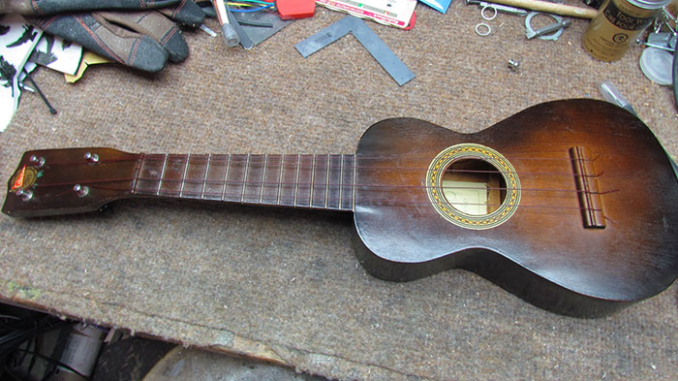
A warped ukulele neck can cause tuning issues and produce a buzzing or muddy tone. This can be due to various factors like heat, humidity, string tension, or natural wear over time. To restore your ukulele’s sound quality, you’ll need to straighten the neck, which can cost a fair bit of money when done professionally. However, there’s a DIY method you can try.

How To Fix A Warped Ukulele Neck
Part 1: Checking the Neck Straightness
- Visual Inspection: Hold your ukulele up to a light source and look for shadows cast by the strings on the fretboard. Any deviations from a smooth shadow indicate warping.
- Repeat Inspection: Rotate the ukulele and check from the headstock to the body for warping, as it may be more noticeable from different angles.
- Use a Straightedge: Place your ukulele on a stable surface and use the strings as a straightedge. Check for gaps between the strings and the frets at different points along the neck.
Part 2: Removing Frets from the Neck
- Prepare Your Tools: Remove the strings and prepare a steam source, like an iron, to loosen the frets.
- Apply Steam: Use the iron to apply steam to the frets, then gently chisel them off using a hammer and scraper.
- Continue Removing Frets: Work your way down the fretboard until all frets are removed.
Part 3: Repairing a Warp in the Neck
- Creating Your Straightening Jig: Cut a cradle block from hard wood to support the neck during straightening.
- Secure the Neck: Clamp the neck securely in the cradle block, ensuring it is positioned to correct the warp.
- Attach Tuning Pegs: Use the B and A tuning pegs to apply tension to the neck, correcting the warp.
- Adjust Tuning Pegs: Gradually tighten or loosen the tuning pegs while monitoring the neck’s straightness using straightedges.
- Apply Heat: Use a metal straight edge to buffer the neck from direct heat, then apply heat evenly to set the new shape of the neck.
- Reattach Fretboard and Restring: Once the neck is straightened and cooled, reattach the fretboard, restring the ukulele, and it should be ready to play.
Things to consider before attempting to fix your Ukulele neck
- Safety Concern: Fixing a warped ukulele neck requires specific tools, knowledge, and techniques. Attempting a repair without proper expertise can damage the instrument further or even cause injury. It’s highly recommended to consult a professional luthier experienced in ukulele repairs for any significant neck warpage.
- Complexity & Individuality: There are various causes and degrees of neck warpage, each requiring a different approach. Techniques involving heat, clamps, truss rods, and refretting demand expert assessment and execution.
- Liability: Providing detailed instructions online could lead to misinterpretation or misuse, potentially causing harm to users and instruments. I wouldn’t want to be responsible for such outcomes.
Warped Ukulele Neck Considerations
Recognize the Signs:
- Uneven string action (strings too high or low on certain frets)
- Buzzing or fretting out on specific frets
- Difficulty achieving proper intonation
- Visible bowing or twisting of the neck
Seek Professional Help:
- Find a qualified luthier experienced in ukulele repairs. Look for reviews, recommendations, and examples of their work.
- Describe the symptoms and provide pictures of the ukulele.
- Discuss the estimated cost and repair timeline.
Alternative Solutions:
- If the warpage is mild and doesn’t significantly impact playability, adjustments like minor truss rod tweaks or saddle compensation might be possible. However, proceed with caution and seek professional guidance to avoid further damage.
- For very minor warpage, raising the action slightly at the bridge might compensate if you’re comfortable making small adjustments without affecting playability significantly.
Preventative Measures:
- Store your ukulele properly in a cool, humidified environment to prevent wood contraction and expansion.
- Avoid extreme temperature changes and direct sunlight exposure.
- Don’t apply excessive string tension. Use gauge strings recommended for your ukulele scale length.
- Loosen strings before storing your ukulele for extended periods.
Remember, the health and lifespan of your ukulele are valuable. While DIY repairs might seem tempting, entrusting your instrument to a qualified professional ensures proper diagnosis, safe repairs, and ultimately, continued enjoyment of your ukulele.
Check out our Free Ukulele Tabs resource
How to Tune a Ukulele
How to play Roslyn by Bon Iver on Ukulele
Hakuna Matata – Lion King – Ukulele Tutorial
How To Play ‘Can’t Help Falling In Love’ on Ukulele
How To Improve Ukulele Strumming Speed
